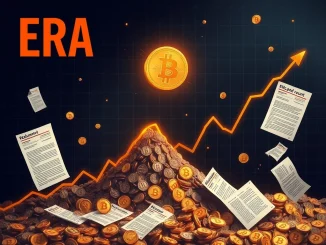
In a development that has sent ripples through the decentralized finance (DeFi) community, the individual responsible for a recent exploit on the GMX protocol has reportedly communicated a surprising intention. An onchain message, traced back to the address associated with the unauthorized withdrawal of funds, suggests that the stolen funds may eventually be returned.
This unusual turn of events was first highlighted by JinSe Finance, citing activity on the blockchain explorer. The message, sent directly to the GMX deployer address, contained a simple but significant claim: the funds taken during the recent incident would be sent back at a later time. Such direct communication from an attacker is uncommon in the world of crypto exploits, where perpetrators typically vanish into the digital ether.
Understanding the GMX Incident and the Onchain Message
The incident involving the GMX hacker saw a significant amount of cryptocurrency removed from the protocol. While the exact mechanism of the exploit and the precise value of the assets taken are subjects of ongoing analysis by security researchers and the GMX team, the core event was a breach that allowed unauthorized access to protocol-controlled funds.
The communication from the attacker wasn’t a typical email or chat message. Instead, it was embedded within a transaction on the blockchain itself, a method often used for broadcasting messages in a verifiable and immutable way. This onchain message serves as a digital signature, proving the communication originated from the address holding the stolen assets.
What does an onchain message mean in this context?
- Verifiability: The message is permanently recorded on the public ledger, linked directly to the address controlling the funds.
- Authenticity: It’s strong evidence that the person controlling the funds is the one sending the message.
- Transparency: Anyone can view the message by inspecting the transaction details.
While the message claims an intention to return the funds, it provides no timeline or specific conditions. This leaves the community and the GMX team in a state of anticipation and uncertainty.
Why Would a GMX Hacker Promise to Return Stolen Funds?
The motivation behind a hacker’s decision to return stolen funds can be complex and varied. It’s not a common occurrence, but it has happened in past crypto exploits. Several factors could be at play:
- Difficulty in Laundering: Large sums of traceable cryptocurrency can be difficult to convert into usable fiat or less traceable assets without leaving a trail that can be followed by investigators and analytics firms.
- Pressure from Tracing Efforts: Blockchain analytics companies and law enforcement agencies are becoming increasingly sophisticated at tracing fund flows. The hacker might feel the net closing in.
- Negotiation or Bounty: The hacker might be signaling a willingness to negotiate a bounty for identifying the vulnerability or returning the majority of funds.
- Moral or Ethical Reasons: Although rare, some hackers, sometimes referred to as ‘white hats’ or ‘grey hats’, exploit vulnerabilities to expose them rather than purely for financial gain, and may return funds after proving their point.
- Community Backlash: Facing severe backlash from the decentralized community and potentially being doxxed can also be a factor.
- Minimizing Legal Consequences: Returning funds, or a portion of them, can sometimes lead to reduced legal repercussions if caught.
Without direct communication or further actions from the GMX hacker, these remain speculative reasons. The promise itself, however, introduces a new dimension to the incident.
Navigating Crypto Security Challenges in DeFi
This incident, regardless of the outcome regarding the return of funds, highlights the persistent crypto security challenges within the DeFi space. Protocols like GMX, which handle significant amounts of user capital, are attractive targets for malicious actors.
Key security considerations for DeFi protocols and users include:

DeFi protocols face constant security threats.
For Protocols:
- Rigorous Audits: Protocols must undergo multiple, independent security audits by reputable firms.
- Bug Bounties: Implementing robust bug bounty programs incentivizes ethical hackers to find and report vulnerabilities.
- Monitoring and Incident Response: Having systems in place to detect suspicious activity quickly and a clear plan for responding to exploits.
- Progressive Decentralization: Carefully managing upgradeability and administrative keys.
For Users:
- Due Diligence: Researching the security track record and audit history of protocols before depositing funds.
- Understanding Risks: Being aware that smart contract risk and exploit risk are inherent in DeFi.
- Secure Wallets: Using hardware wallets and practicing good key management hygiene.
- Staying Informed: Following reliable news sources and community channels for security alerts.
The promise from the GMX hacker doesn’t erase the fact that a DeFi exploit occurred. It underscores the need for continuous vigilance and improvement in security practices across the ecosystem.
Tracing Stolen Funds: The Role of Blockchain Analytics
One of the reasons a hacker might consider returning funds is the increasing capability of tracing stolen crypto. While transactions on public blockchains are pseudonymous, they are also transparent. This allows specialized firms to follow the money trail.
How does tracing work?
Blockchain analytics companies use sophisticated software to analyze transaction patterns, identify connections between addresses, and sometimes link onchain activity to real-world entities. They track funds as they move through different wallets, mixers, exchanges, and DeFi protocols. The goal is often to identify endpoints where crypto might be cashed out or converted, potentially revealing the identity of the perpetrator.
The transparency of the blockchain, ironically, can be a powerful tool against illicit activity. The longer a hacker holds onto large amounts of traceable crypto, the higher the risk of being identified.
Community Reaction and Future Implications
The reaction from the GMX community and the broader crypto space to the hacker’s message has been a mix of skepticism, hope, and intrigue. While some remain doubtful that the funds will actually be returned, others see it as a potentially positive development that could mitigate the damage from the exploit.
If the GMX hacker does follow through on the promise, it could set a precedent, or at least spark further discussion, about the dynamics between exploiters and protocols. It highlights that even in the largely anonymous world of crypto, actions can have consequences, and the pressure from tracing and community attention can be significant.
This incident serves as a reminder that the DeFi space is still maturing. While offering innovative financial opportunities, it also presents unique security challenges that require constant adaptation from developers, security experts, and users alike. The outcome of the DeFi exploit on GMX and the hacker’s subsequent actions will be closely watched, offering valuable lessons for the entire ecosystem.
Conclusion: Awaiting the Outcome of the GMX Hacker’s Promise
The news that the GMX hacker has sent an onchain message promising to return the stolen funds is an unexpected twist in a typical DeFi exploit scenario. It introduces a layer of uncertainty and potential resolution to an otherwise damaging event. While the motivations behind the hacker’s claim remain unclear, and the actual return of funds is not guaranteed, the transparency of the blockchain has allowed this communication to come to light.
This incident underscores the critical importance of robust crypto security measures for both protocols and users. The increasing capabilities of tracing stolen assets may be influencing hacker behavior, potentially making it harder for large-scale exploits to be profitable without significant risk. The community now waits to see if the promise will be fulfilled, an outcome that will undoubtedly have implications for the narrative around this specific exploit and potentially for how similar incidents are handled in the future. Regardless of the return, the focus remains on strengthening security to prevent such exploits from happening in the first place.



